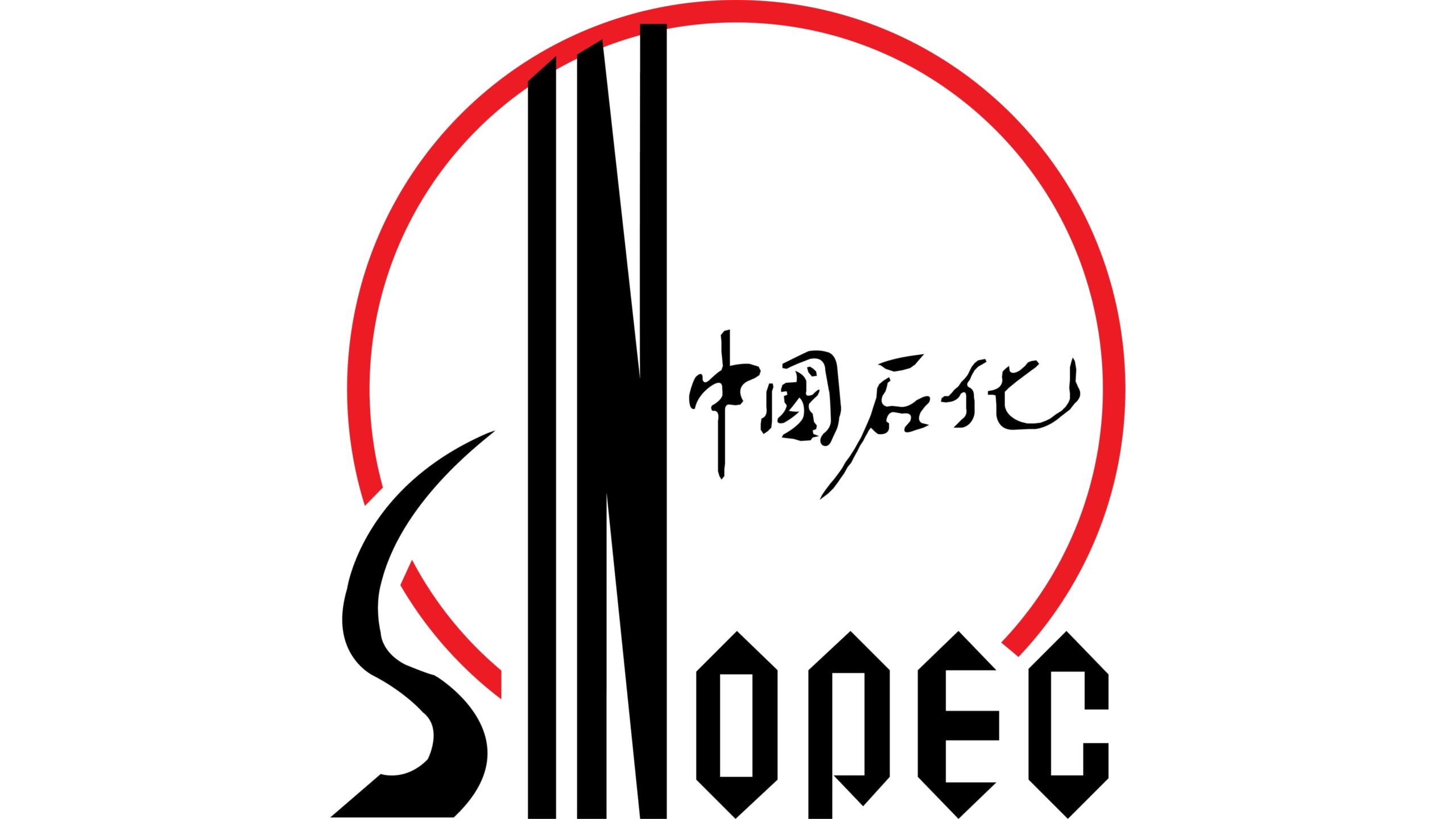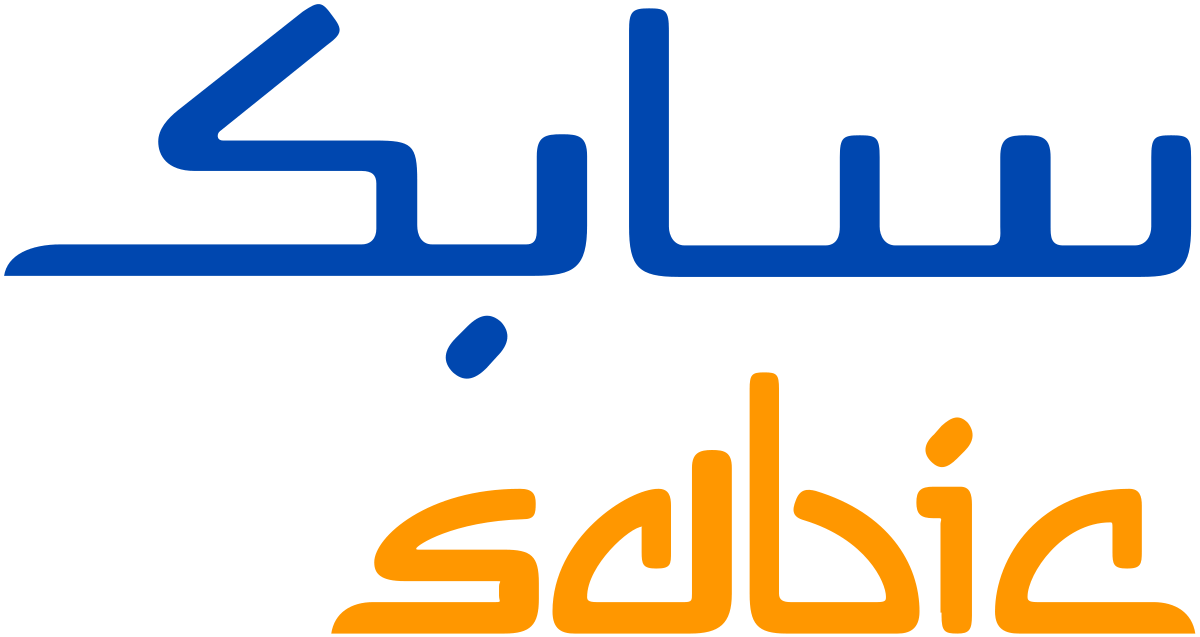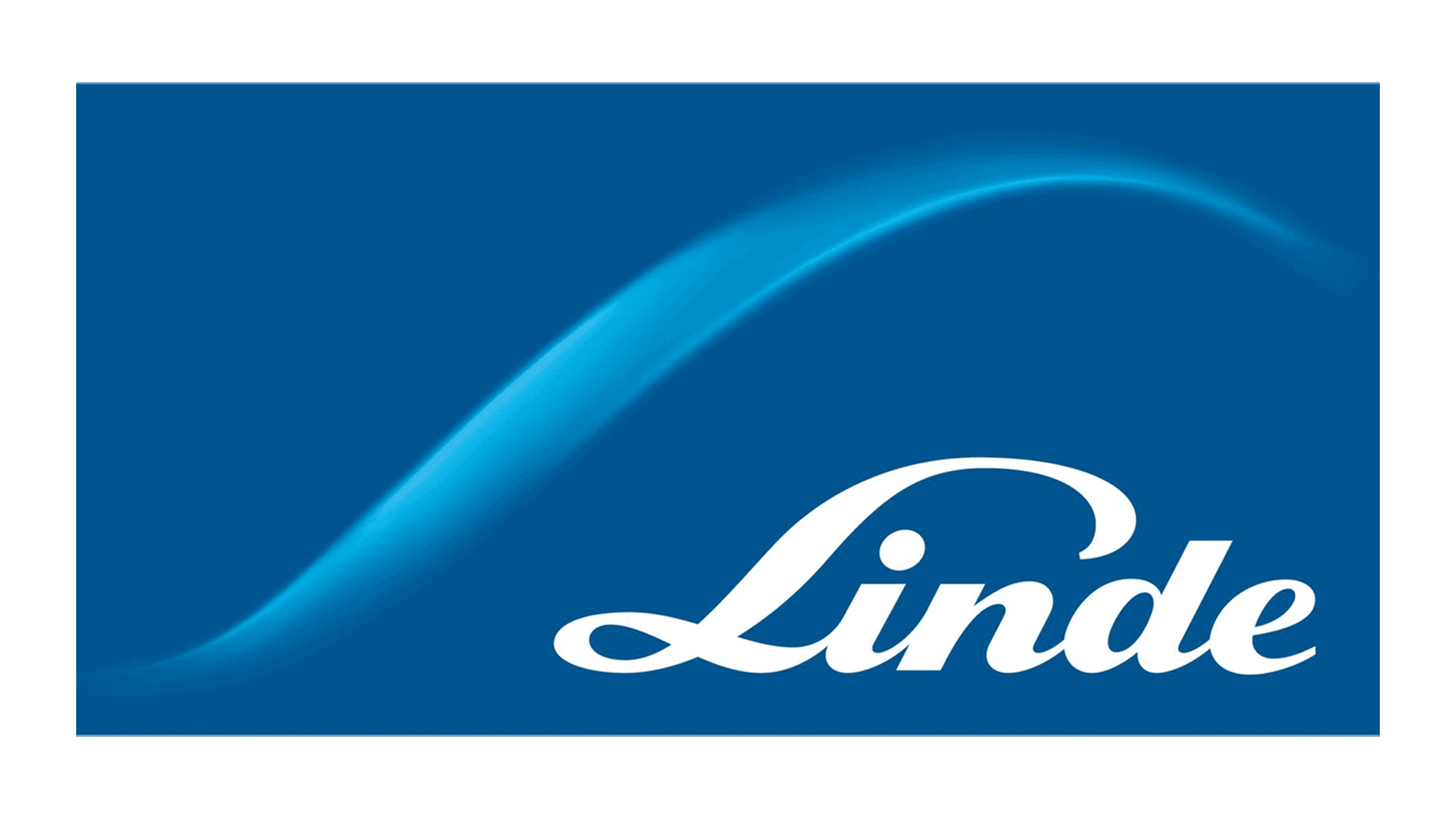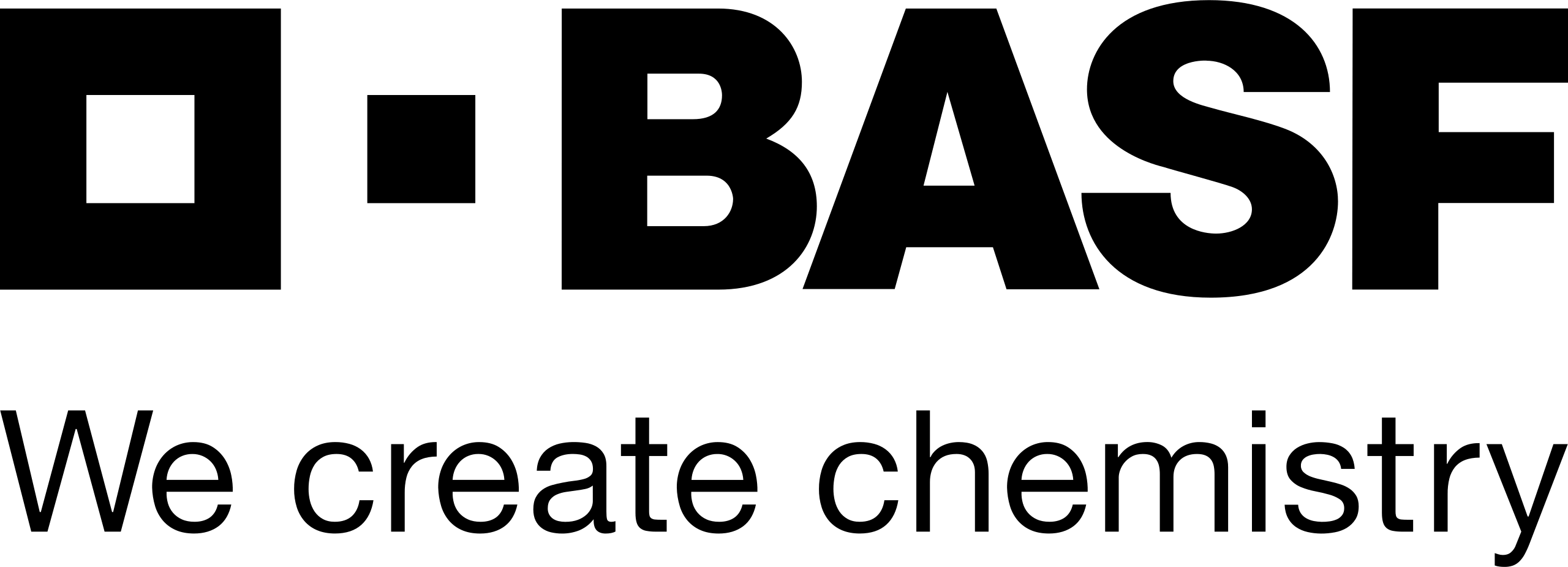Global Surface Disinfectant Market By Composition, By Formulation, By Type, By Distribution Channel, By End User, By Region & Segmental Insights Trends and Forecast, 2024 – 2034
- Industry: Chemicals & Materials
- Report ID: TNR-110-1238
- Number of Pages: 420
- Table/Charts : Yes
- August, 2024
- Base Year : 2024
- No. of Companies : 10+
- No. of Countries : 29
- Views : 10082
- Covid Impact Covered: Yes
- War Impact Covered: Yes
- Formats : PDF, Excel, PPT
The global surface disinfectant market is experiencing robust growth driven by increasing awareness of hygiene and the rising prevalence of infectious diseases. The demand is fueled by stringent regulatory standards in healthcare settings and growing consumer focus on cleanliness in residential and commercial spaces. Key trends include the shift towards eco-friendly and bio-based disinfectants, reflecting environmental concerns, and the rise of ready-to-use formulations like wipes and sprays for convenience.
Technological advancements in disinfectant efficacy and application methods are creating new opportunities, particularly in healthcare and food processing industries. Emerging markets in Asia-Pacific and Latin America present significant growth prospects due to improving healthcare infrastructure and rising disposable incomes. In terms of revenue, the global surface disinfectant market was worth US$ 5.9 Bn in 2023, anticipated to witness a CAGR of 7.8% during 2024 – 2034.
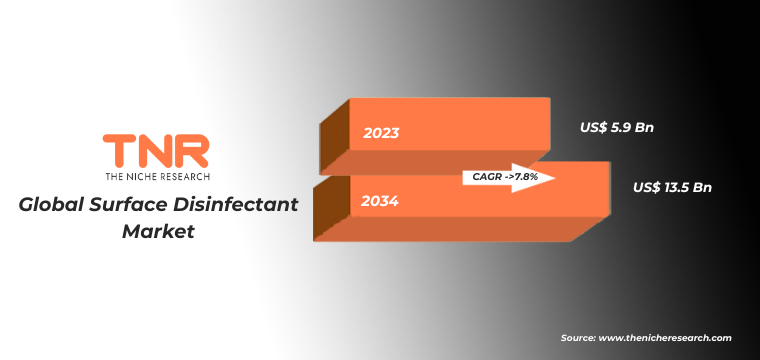
Trends in the Global Surface Disinfectant Market
Shift Towards Eco-Friendly Disinfectants- As consumers and businesses become increasingly aware of environmental issues, there is a rising demand for products that are effective yet sustainable. Manufacturers are responding by developing disinfectants made from natural ingredients and biodegradable formulations that minimize harmful chemical residues. This trend is particularly strong in regions with strict environmental regulations, such as Europe and North America, where eco-conscious consumers and businesses prioritize green products, driving innovation and growth in this segment of the market.
Increased Demand for Ready-to-Use Formulations- The demand for ready-to-use (RTU) formulations, such as disinfectant wipes, sprays, and pre-saturated cloths, is on the rise in the global surface disinfectant market. This trend is driven by the convenience and ease of use that these products offer, particularly in fast-paced environments like healthcare facilities, offices, and homes. RTU disinfectants eliminate the need for dilution or preparation, saving time and reducing the risk of improper mixing. As hygiene standards become more stringent across various sectors, the preference for these user-friendly and efficient products is growing, fueling their adoption and driving market expansion globally.
Global Surface Disinfectant Market Revenue & Forecast, (US$ Million), 2016 – 2034
Bio-based disinfectants segment have seen a surge in popularity recently, emerging as the fastest-growing segment in the global surface disinfectant market. This surge in popularity is driven by increasing consumer demand for environmentally friendly and sustainable products. Unlike traditional chemical disinfectants, bio-based options are derived from natural sources, offering effective germ-killing capabilities without harmful residues. Heightened awareness of health and environmental impacts, along with stricter regulations on chemical usage, has accelerated this trend. As businesses and consumers alike prioritize green solutions, the market for bio-based disinfectants is expected to continue its robust growth trajectory.

In 2023, liquids segment by formulation category led the global surface disinfectant market, commanding a significant revenue share of 45.2%. This leadership is attributed to the versatility and effectiveness of liquid disinfectants across various applications, including healthcare, commercial, and residential settings. Liquid formulations are favored for their ease of application, strong penetration, and broad-spectrum efficacy against pathogens. Their ability to be used in both concentrated and diluted forms offers flexibility, catering to diverse user needs. As hygiene standards remain stringent worldwide, the liquids segment continues to be a preferred choice, driving its strong market presence.
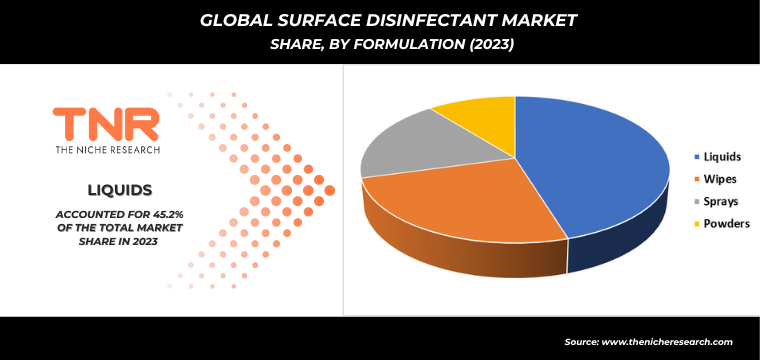
Intermediate-level disinfectants segment by type emerged as the fastest growing segment in the global surface disinfectant market, capturing a notable revenue share of 32.7%. This growth is driven by their broad-spectrum efficacy against a wide range of pathogens, including bacteria, viruses, and fungi, making them ideal for use in healthcare settings, laboratories, and other high-risk environments. Intermediate-level disinfectants strike a balance between high-level disinfectants’ rigorous sterilization and low-level options’ more general use, appealing to sectors that require reliable yet versatile disinfection. As infection control becomes increasingly critical, this segment’s market share continues to expand.
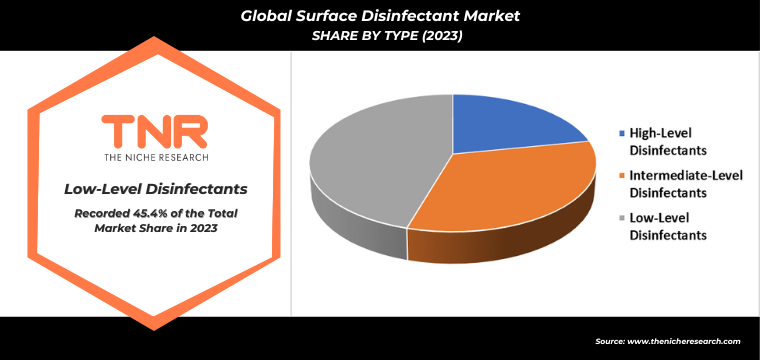
Offline segment by distribution channel achieved the highest share in the global surface disinfectant market in 2023. This dominance is driven by the continued preference for purchasing disinfectants from traditional brick-and-mortar stores, such as supermarkets, hypermarkets, and specialty stores. Consumers and businesses often favor offline channels for their ability to physically examine products, access immediate purchases, and receive in-store guidance. Additionally, the presence of established retail networks and widespread availability in healthcare and commercial settings contribute to the offline segment’s strong market performance. Despite the growth of online shopping, offline channels remain crucial, particularly in regions where internet penetration is lower.
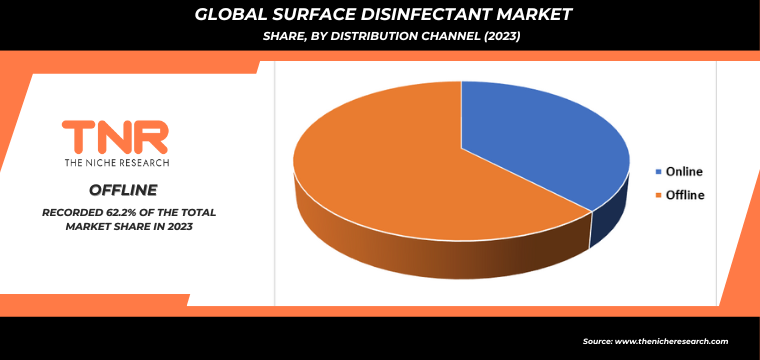
By end user, commercial segment led the global surface disinfectant market in 2023 with a CAGR of 5.8%. This growth is driven by increased demand for disinfectants in commercial settings such as offices, retail spaces, hospitality, and transportation. The need to maintain high hygiene standards in these environments, particularly in response to health concerns and regulatory requirements, has fueled the adoption of surface disinfectants. As businesses prioritize customer and employee safety, the commercial segment continues to expand, reinforcing its significant role in driving overall market growth.
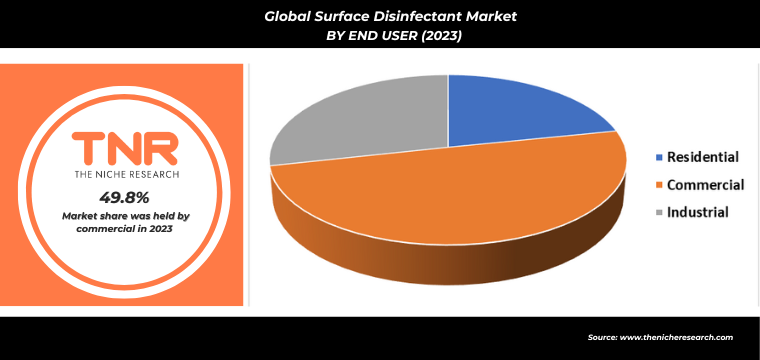
Latin America is anticipated as the fastest growing region during the forecast timeline. This rapid growth is driven by increasing awareness of hygiene, rising healthcare investments, and the expansion of infrastructure across the region. The demand for surface disinfectants is further fueled by the growing prevalence of infectious diseases and the need for stringent sanitation protocols in public spaces, healthcare facilities, and commercial establishments. As economies in Latin America continue to develop and urbanize, the market for surface disinfectants is expected to see significant expansion, positioning the region as a key growth area.
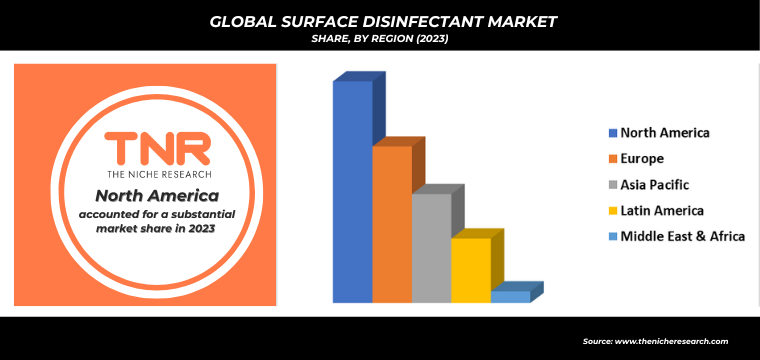
Competitive Landscape
The competitive landscape of the global surface disinfectant market is marked by significant players focusing on innovation, eco-friendly formulations, and strategic mergers. Leading companies strive to enhance product efficacy and expand their market presence globally.
Some of the players operating in the surface disinfectant market are
- 3M Company
- Arkema
- BASF SE
- Cantel Medical Corporation
- Clariant International
- DuPont
- Ecolab
- Gojo Industries, Inc.
- LANXESS AG
- Lonza Group
- Medline Industries, Inc.
- Metrex Research, LLC
- Paul Hartmann AG
- Pharmax Limited
- Procter & Gamble
- Reckitt Benckiser Group PLC
- Steris Plc.
- The Clorox Company
- Whiteley Corporation
- Other Industry Participants
Global Surface Disinfectant Market Scope
| Report Specifications | Details |
| Market Revenue in 2023 | US$ 5.9 Bn |
| Market Size Forecast by 2034 | US$ 13.5 Bn |
| Growth Rate (CAGR) | 7.8% |
| Historic Data | 2016 – 2022 |
| Base Year for Estimation | 2023 |
| Forecast Period | 2024 – 2034 |
| Report Inclusions | Market Size & Estimates, Market Dynamics, Competitive Scenario, Trends, Growth Factors, Market Determinants, Key Investment Segmentation, Product/Service/Solutions Benchmarking |
| Segments Covered | By Composition, By Formulation, By Type, By Distribution Channel, By End User, By Region |
| Regions Covered | North America, Europe, Asia Pacific, Middle East & Africa, Latin America |
| Countries Covered | U.S., Canada, Mexico, Rest of North America, France, The UK, Spain, Germany, Italy, Nordic Countries (Denmark, Finland, Iceland, Sweden, Norway), Benelux Union (Belgium, The Netherlands, Luxembourg), Rest of Europe, China, Japan, India, New Zealand, Australia, South Korea, Southeast Asia (Indonesia, Thailand, Malaysia, Singapore, Rest of Southeast Asia), Rest of Asia Pacific, Saudi Arabia, UAE, Egypt, Kuwait, South Africa, Rest of Middle East & Africa, Brazil, Argentina, Rest of Latin America |
| Key Players | 3M Company, Arkema, BASF SE, Cantel Medical Corporation, Clariant International, DuPont, Ecolab, Gojo Industries, Inc., LANXESS AG, Lonza Group, Medline Industries, Inc., Metrex Research, LLC, Paul Hartmann AG, Pharmax Limited, Procter & Gamble, Reckitt Benckiser Group PLC, Steris Plc., The Clorox Company, Whiteley Corporation |
| Customization Scope | Customization allows for the inclusion/modification of content pertaining to geographical regions, countries, and specific market segments. |
| Pricing & Procurement Options | Explore purchase options tailored to your specific research requirements |
| Contact Details | Consult With Our Expert
Japan (Toll-Free): +81 663-386-8111 South Korea (Toll-Free): +82-808- 703-126 Saudi Arabia (Toll-Free): +966 800-850-1643 United Kingdom: +44 753-710-5080 United States: +1 302-232-5106 E-mail: askanexpert@thenicheresearch.com
|
Global Surface Disinfectant Market
By Composition
- Chemical Disinfectants
- Quaternary Ammonium Compounds
- Alcohols
- Aldehydes
- Phenolic Compounds
- Oxidizing Agents
- Chlorine Compounds
- Hydrogen Peroxide
- Peracetic Acid
- Other Chemical Disinfectants
- Bio-Based Disinfectants
By Formulation
- Liquids
- Wipes
- Sprays
- Powders
By Type
- High-Level Disinfectants
- Intermediate-Level Disinfectants
- Low-Level Disinfectants
By Distribution Channel
- Online
- Offline
- Retail Pharmacies
- Supermarkets/Hypermarkets
- Specialty Stores
By End User
- Residential
- Commercial
- Industrial
By Region
- North America (U.S., Canada, Mexico, Rest of North America)
- Europe (France, The UK, Spain, Germany, Italy, Nordic Countries (Denmark, Finland, Iceland, Sweden, Norway), Benelux Union (Belgium, The Netherlands, Luxembourg), Rest of Europe)
- Asia Pacific (China, Japan, India, New Zealand, Australia, South Korea, Southeast Asia (Indonesia, Thailand, Malaysia, Singapore, Rest of Southeast Asia), Rest of Asia Pacific)
- Middle East & Africa (Saudi Arabia, UAE, Egypt, Kuwait, South Africa, Rest of Middle East & Africa)
- Latin America (Brazil, Argentina, Rest of Latin America)
Report Layout:
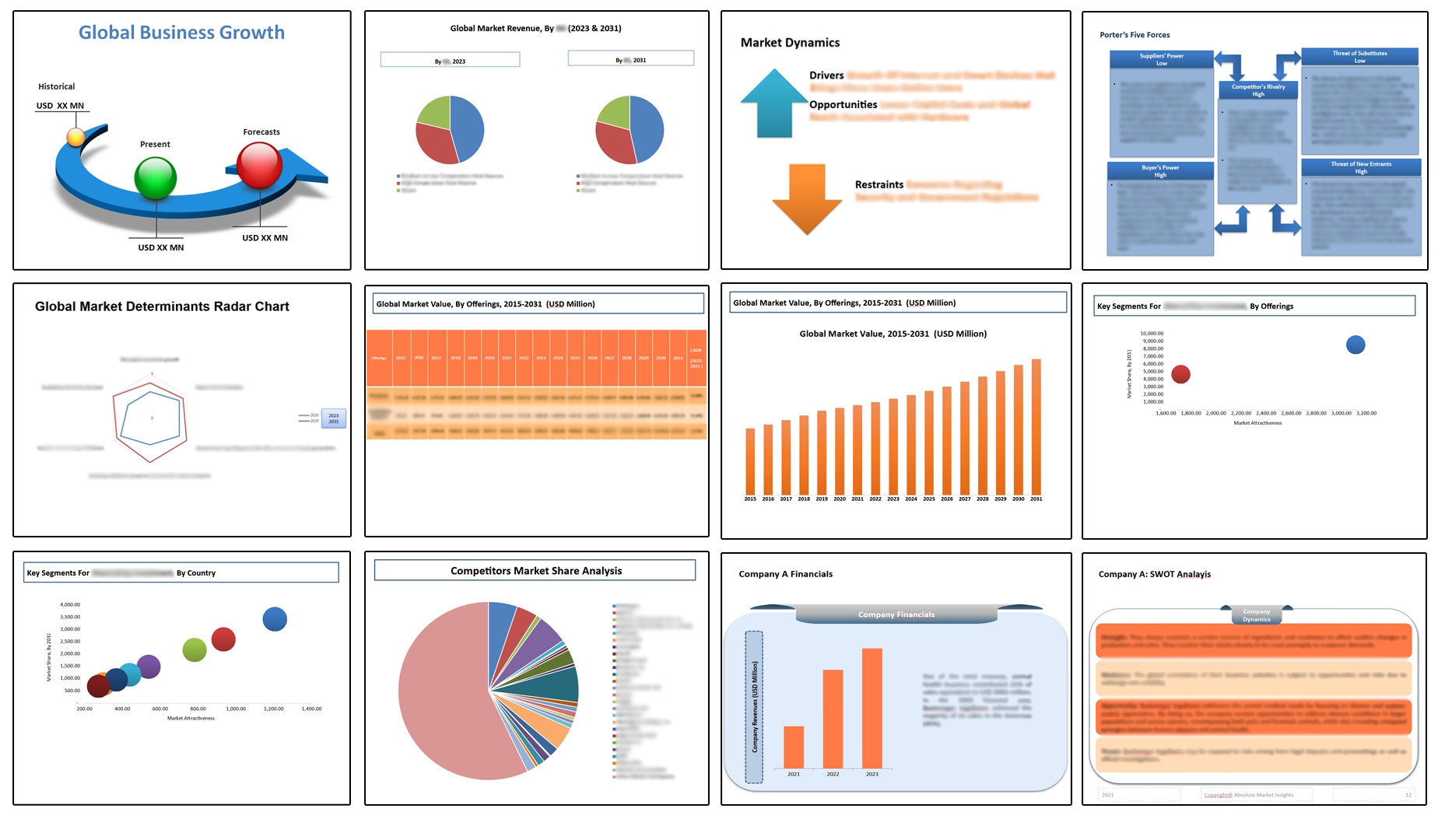
Table of Contents
**Exclusive for Multi-User and Enterprise User.
Global Surface Disinfectant Market
By Composition
- Chemical Disinfectants
- Quaternary Ammonium Compounds
- Alcohols
- Aldehydes
- Phenolic Compounds
- Oxidizing Agents
- Chlorine Compounds
- Hydrogen Peroxide
- Peracetic Acid
- Other Chemical Disinfectants
- Bio-Based Disinfectants
By Formulation
- Liquids
- Wipes
- Sprays
- Powders
By Type
- High-Level Disinfectants
- Intermediate-Level Disinfectants
- Low-Level Disinfectants
By Distribution Channel
- Online
- Offline
- Retail Pharmacies
- Supermarkets/Hypermarkets
- Specialty Stores
By End User
- Residential
- Commercial
- Industrial
By Region
- North America (U.S., Canada, Mexico, Rest of North America)
- Europe (France, The UK, Spain, Germany, Italy, Nordic Countries (Denmark, Finland, Iceland, Sweden, Norway), Benelux Union (Belgium, The Netherlands, Luxembourg), Rest of Europe)
- Asia Pacific (China, Japan, India, New Zealand, Australia, South Korea, Southeast Asia (Indonesia, Thailand, Malaysia, Singapore, Rest of Southeast Asia), Rest of Asia Pacific)
- Middle East & Africa (Saudi Arabia, UAE, Egypt, Kuwait, South Africa, Rest of Middle East & Africa)
- Latin America (Brazil, Argentina, Rest of Latin America)
The Niche Research approach encompasses both primary and secondary research methods to provide comprehensive insights. While primary research is the cornerstone of our studies, we also incorporate secondary research sources such as company annual reports, premium industry databases, press releases, industry journals, and white papers.
Within our primary research, we actively engage with various industry stakeholders, conducting paid interviews and surveys. Our meticulous analysis extends to every market participant in major countries, allowing us to thoroughly examine their portfolios, calculate market shares, and segment revenues.
Our data collection primarily focuses on individual countries within our research scope, enabling us to estimate regional market sizes. Typically, we employ a bottom-up approach, meticulously tracking trends in different countries. We analyze growth drivers, constraints, technological innovations, and opportunities for each country, ultimately arriving at regional figures.Our process begins by examining the growth prospects of each country. Building upon these insights, we project growth and trends for the entire region. Finally, we utilize our proprietary model to refine estimations and forecasts.
Our data validation standards are integral to ensuring the reliability and accuracy of our research findings. Here’s a breakdown of our data validation processes and the stakeholders we engage with during our primary research:
- Supply Side Analysis: We initiate a supply side analysis by directly contacting market participants, through telephonic interviews and questionnaires containing both open-ended and close-ended questions. We gather information on their portfolios, segment revenues, developments, and growth strategies.
- Demand Side Analysis: To gain insights into adoption trends and consumer preferences, we reach out to target customers and users (non-vendors). This information forms a vital part of the qualitative analysis section of our reports, covering market dynamics, adoption trends, consumer behavior, spending patterns, and other related aspects.
- Consultant Insights: We tap into the expertise of our partner consultants from around the world to obtain their unique viewpoints and perspectives. Their insights contribute to a well-rounded understanding of the markets under investigation.
- In-House Validation: To ensure data accuracy and reliability, we conduct cross-validation of data points and information through our in-house team of consultants and utilize advanced data modeling tools for thorough verification.
The forecasts we provide are based on a comprehensive assessment of various factors, including:
- Market Trends and Past Performance (Last Five Years): We accurately analyze market trends and performance data from preceding five years to identify historical patterns and understand the market’s evolution.
- Historical Performance and Growth of Market Participants: We assess the historical performance and growth trajectories of key market participants. This analysis provides insights into the competitive landscape and individual company strategies.
- Market Determinants Impact Analysis (Next Eight Years): We conduct a rigorous analysis of the factors that are projected to influence the market over the next eight years. This includes assessing both internal and external determinants that can shape market dynamics.
- Drivers and Challenges for the Forecast Period:Identify the factors expected to drive market growth during the forecast period, as well as the challenges that the industry may face. This analysis aids in deriving an accurate growth rate projection.
- New Acquisitions, Collaborations, or Partnerships: We keep a close watch on any new acquisitions, collaborations, or partnerships within the industry. These developments can have a significant impact on market dynamics and competitiveness.
- Macro and Micro Factors Analysis:A thorough examination of both macro-level factors (e.g., economic trends, regulatory changes) and micro-level factors (e.g., technological advancements, consumer preferences) that may influence the market during the forecast period.
- End-User Sentiment Analysis: To understand the market from the end-user perspective, we conduct sentiment analysis. This involves assessing the sentiment, preferences, and feedback of the end-users, which can provide valuable insights into market trends.
- Perspective of Primary Participants: Insights gathered directly from primary research participants play a crucial role in shaping our forecasts. Their perspectives and experiences provide valuable qualitative data.
- Year-on-Year Growth Trend: We utilize a year-on-year growth trend based on historical market growth and expected future trends. This helps in formulating our growth projections, aligning them with the market’s historical performance.
Research process adopted by TNR involves multiple stages, including data collection, validation, quality checks, and presentation. It’s crucial that the data and information we provide add value to your existing market understanding and expertise. We have also established partnerships with business consulting, research, and survey organizations across regions and globally to collaborate on regional analysis and data validation, ensuring the highest level of accuracy and reliability in our reports.


